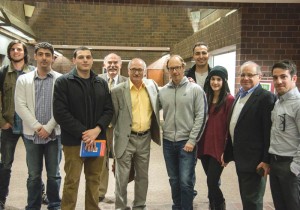Aramayis Orkusyan
Editor

Photo: Hourig Attarian
In the aftermath of the second Russo-Iranian War, which concluded on February 10, 1828 with the signing of the Treaty of Turkmenchay, anti-Russian sentiments in Iran were rampant. After the ratification of the Treaty, an angry mob stormed the Russian embassy in Tehran, Iran and murdered Alexander Griboedov, Russia’s ambassador to Iran, and all but one of the embassy’s staff. Dr. Bournoutian’s lecture on January 28, 2016 titled “Iran’s Mission of Apology to Russia” discussed the Iranian government’s response to these massacres. The lecture was co-sponsored by the Armenian Studies Program and the Armenian General Benevolent Union of Fresno.
In order to prevent the outbreak of another war, the Shah of Iran sent an official mission of apology to Tsar Nicholas I. In his lecture, Dr. Bournoutian detailed the ten-month long journey from Tabriz to St. Petersburg headed by Khosrow Mirza—the seventh son of the Crown Prince of Iran Abbas Mirza. Scholars know some of the details of the journey due to a diary that was kept by Khosrow Mirza’s secretary during the entire trip. “In the diary we have unbelievable material on what kind of palaces they went to, what kind of soirees they had, fireworks they saw, presents, you name it,” said Dr. Bournoutian.
However, the diary of the Iranian secretary painted an incomplete picture of the journey. Crucial information, such as the return trip to Iran and events to which the secretary was not allowed to attend, were missing in the diary. Additionally, much of the information in the diary was riddled with inaccuracies caused by the language barrier of the secretary. “All the Russian generals, all the Russian villages, and the cities are undecipherable,” said Dr. Bournoutian.
Dr. Bournoutian discussed his long quest to fill in the gaps in the diary of the Iranian secretary. Compiling information from Russian sources such as the confidential diaries of General Rennenkampf, who acted as the Iranian delegate’s host during their trip to St. Petersburg, reports from the secret police of Tsar Nicholas I, and reports of the Governor of Moscow, Dr. Bournoutian was able to paint a complete picture of the journey of the Iranian delegates.
Although seemingly unrelated to Armenia, the Treaty of Turkmenchay, which is what ultimately created the need to send a mission of apology to Russia, was also important in the eventual formation of the first Armenian Republic. Dr. Bournoutian explained that Article 15 of the Treaty allowed Armenians, who 200 years before were forcibly deported by Shah Abbas from the region of Nakhichevan, Yerevan, and Julfa, one year to repatriate to Russia’s newly created Armenian province.
Although Armenians already lived in the region, they only constituted about 30% of the population, whereas the other 70% were Muslim. “Russians kept very detailed statistics,” said Dr. Bournoutian. “We have the statistics and two years later, this Armenian province had 50% Armenians 50% Muslims, and very soon the Armenians begin to have more and more, and the new Armenia was born.”
In 1976 Dr. Bournoutian received a Ph.D. from UCLA with a dissertation on “Eastern Armenia on the Eve of the Russian Conquest,” the first Ph.D. in Armenian History from UCLA, and is now a senior professor of history at Iona College in New Rochelle, New York.
Dr. Bournoutian has authored 30 books with 4 more in the press. His groundbreaking A Concise History of the Armenian People, currently in its sixth edition, has sold over 20,000 copies. It is used in many institutions of higher education and has been translated into Spanish, Turkish, Arabic, Armenian, Russian, and most recently in Japanese.
Dr. Bournoutian has been a distinguished visiting professor in many universities across the United States, including Fresno State, where he was the 7th Kazan Visiting Professor of Armenian Studies in Spring 2009.
 Hye Sharzhoom Armenian Action
Hye Sharzhoom Armenian Action